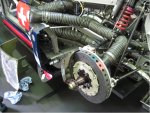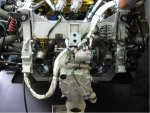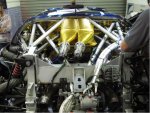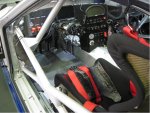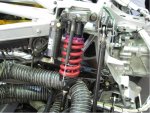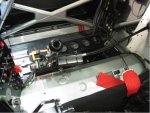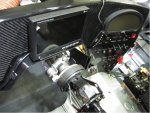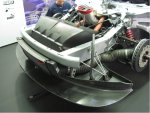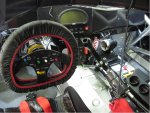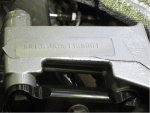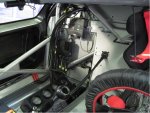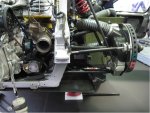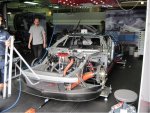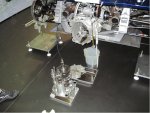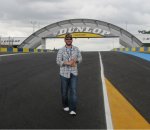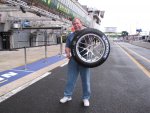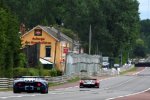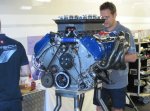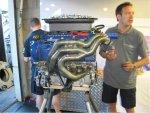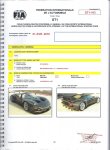Gentlemen,
Day two, Tuesday, we had many more Forum members in attendance. Again, no cars would be on the track until tomorrow so I spent this day learning about the track, the cars, the drivers, and the current rules governing the 24 Hours of Le Mans.
First, the track. It is so big, about 8 1/2 miles, it’s hard to form a good mental picture. It has changed over a dozen times since the inaugural race in the 1920s. It use to be over 10 miles long and had far fewer turns. Since the 1966 1-2-3 Ford GT victory there have been five major modifications to the racetrack at Le Mans. The 3 ½ mile long Mulsanne straight has had two chicanes added at about 1 mile intervals to slow the cars down. The Porsche curve was added about one half mile before the grand stand straight, and the Ford curve was added to slow traffic just before that grandstand straight. The Dunlap chicane was added just before the giant Dunlap Tire bridge. I decided the only way to get a real feel for this track was to walk its entire length. DBK, Andy & Margaret, and Ralphie (who took a short cut) agreed to accompany me. Andy Benedict did an excellent write up on the track itself so I will not repeat it here. About 3/4 of the entire race track consists of public roads that would not be closed until shortly before the first practice session tomorrow. The racetrack surface on both the public road and private parts of the course was uniformly excellent. Moving as rapidly as we could it still took well over two hours to cover the 8 ½ miles. The small hotels and ancient buildings pictured along the side of the race track in Steve McQueen’s 1970 movie Le Mans are exactly the same today as they were back then. The entire race track is marginally lit at night. It is not brightly lit, but there is enough light such that you could drive it with your headlights off. The vast majority of this race track passes through a forest of trees and very few areas contained a grandstand. Walking the 8 ½ mile track was physically tiring but very worthwhile.
The cars. How similar are they to the Ford GTs that we drive? Current GT-1 rules require that these cars use regular production car frames and chassis (passenger compartments). The chassis complete with front and rear sub-frames, and bumpers are regular production Ford GT pieces. That is where the similarity ends however. The doors, fenders, clamshell, hood, front and rear splitters, and belly pans are all very lightweight carbon fiber reproductions. Windshield and side windows are shatterproof polycarbonate. The polycarbonate side windows are fixed in place and do not roll down, just like the 1960s originals. There is no back window between the passenger and engine compartments and in its place is a solid firewall. A rear facing camera mounted to the top of the rear bumper with a screen on the dash provides rearward visibility along with the side mirrors. Although Martin has purchased five new Ford GT’s, the current GT-1 cars were built from brand-new replacement tubs complete with front and rear subframes that were purchased from Ford. Matech has stamped their own serial numbers into the frames. The new black Ford GT parked outside of our hospitality area is the car that was used to verify specifications to the FIA on the GT-1 cars for homologation purposes. Because of the unexpectedly high accident rate of the new Ford GT, Ford found it necessary to put the chassis (tub) and subframes back into production to build 100 additional units so that wrecked Ford GT road cars could be rebuilt. In addition to those 100, 14 complete chassis with front & rear subframes were manufactured for Matech and shipped to their shop in Germany. Two of those were turned in to the current GT-1 racecars and the rest will be used if a car is damaged beyond repair or a replacement car needs to be built.
GT-1 rules allow these cars to be 100mm (about 4 inches) wider than stock. You can see this in the photographs taken from above the pit area and looking straight down at the cars. The front and rear fenders bulge out two additional inches on each side. Front and rear suspension A arms are custom-built pieces and rules require their attach points be within 15 mm of a stock GT. Four way adjustable gas/nitrogen KW coil-overs are used at all four corners. LeMans rules require that all closed cockpit cars be equipped with air conditioning that keeps the cabin temperature at a maximum of 32° C. If the cabin temperature exceeds 32° C the car is required to pit until the AC can be fixed. This is to keep the fire suited drivers from overheating during multi-hour stints behind the wheel. In the cockpit photos you can see a big 4 vent A/C unit pointed toward the driver from the floor board where the passenger seat would normally be. The A/C compressor is driven via a belt from a pulley mounted on the right rear half shaft.
Wheels are BBS center bolt, 18 inch diameter, 13 inch wide, front and rear. Five different tire manufacturers raced at Le Mans this year, the Matech team used Michelin. They had on hand both soft and medium compound slicks as well as two different types of rain tires.
Antilock brakes are not allowed in GT-1 although they are allowed in GT-3 competition. The Matech cars used AP Racing six pot mono block calipers with massive carbon fiber discs and carbon fiber pads. Photos display the massive cooling hoses leading from the front brake ducts and rear side scoops of the GT to cool those brakes as well as different color temperature sensitive paint on the edges of the rotors.
The Matech cars do not use the 5.4 L dry sump Ford GT engine. GT-1 rules require that the car be homologated using an engine from the manufacturer (Ford) of the vehicle. The engine used by Matech is the normally aspirated Ford 5.0L “Cammer” 32 valve V-8, built by Roush. The motors are bored and stroked to 5.3L and when breathing through a pair of 31.6 mm restrictors (required by GT-1 rules to balance power between competitors) the motor puts out 560 rearwheel horsepower. Unrestricted the motor puts out about 100 more HP, 665 HP. All GT-1 cars are rear wheel drive only. Those two restrictors can be seen in the photos between the air cleaners and the twin air boxes on top of the engine. These motors are designed to last only “30 hours” and must be returned to Roush in the United States for rebuilding. The motors are delivered to Matech partially disassembled, most likely to ease their way through the scrutinering process where race officials verify that each car complies with existing rules.
At LeMans, each car is allowed two engines. The two engines that will be used must be declared to race officials. Once a car leaves the paddock with an engine, either during qualifying or during the race, the engine in the car must be one of the two declared engines. If it blows up one minute into the first practice, the team has used up one of their two available engines. Thereafter, the second engine would have to be used for all qualifying as well as the entire race itself. Virtually every car at LeMans starts the actual race with a brand-new fresh engine. The teams use a new or low time engine to practice and qualify, and then replace it with a brand-new engine to make it through the actual 24 hour race. If an engine has not left the paddock, it could be swapped for another as long as race officials are informed.
The transmission in the Matech cars is a six speed, sequential, straight cut gear, cassette type transmission. All the guts can be removed, inspected, and replaced within a few minutes. I asked Martin why the team did not use paddle shifters on the steering wheel. He informed me that GT-1 rules stipulate that since the original Ford GT had it’s shifter on the center console, the race car must have its shifter on the center console as well. The race car shifter moves only forward and back because of that sequential transmission.
The roll cage that snakes through and around the entire car is not welded to the frame or the body anywhere. Again, rules prohibit this. The roll cage can only be bolted to the existing structure of the cars. I don’t know the reason for this and forgot to ask. The car’s fuel cell is located in the stock position but is filled through two openings (one filler and one vent) on the top of the hood just in front of the windshield. The car carries enough fuel for just over an hour at race speeds. The tires are normally changed every two hours (depending upon temperature and track condition). The car has onboard air jacks that lift all 4 wheels off the ground when an airhose is connected to a fitting on the right hand side of the car. Tires are not allowed to be changed while the car is being fueled and unlike NASCAR, only two individuals per side are allowed to change the tires. So the back tires are changed first, then the same four individuals, two per side, run to the front to change those tires. This makes tire change/fuel pit stops fairly lengthy so those are also the stops where the team changes drivers.
The car is equipped with two independent starters, either of which can start the car if the other suffers a complete failure. The cars must be shut off while being fueled, so those dual starters are quite important!
For Le Mans the cars are equipped with a ton of MoTec telemetry that is not used for the other GT-1 Series races. Just about everything on the car (shock absorbers, cooling system, engine, transmission, speed, position, etc.) is relaying information back to the pits.
With their lightweight carbon fiber bodywork and devoid of power windows and locks, stereos, and anything else that smacks of creature comfort (except that air conditioner) Matech Ford GTs are 800 pounds lighter than our Ford GTs!! The race cars weigh about 2600 pounds.
So much information was relayed to me on that Tuesday. I don’t have any more time today to write about the drivers, team history, or other matters so I’ll stop for now.
Stay tuned for Part 3. All the best.
Chip
Day two, Tuesday, we had many more Forum members in attendance. Again, no cars would be on the track until tomorrow so I spent this day learning about the track, the cars, the drivers, and the current rules governing the 24 Hours of Le Mans.
First, the track. It is so big, about 8 1/2 miles, it’s hard to form a good mental picture. It has changed over a dozen times since the inaugural race in the 1920s. It use to be over 10 miles long and had far fewer turns. Since the 1966 1-2-3 Ford GT victory there have been five major modifications to the racetrack at Le Mans. The 3 ½ mile long Mulsanne straight has had two chicanes added at about 1 mile intervals to slow the cars down. The Porsche curve was added about one half mile before the grand stand straight, and the Ford curve was added to slow traffic just before that grandstand straight. The Dunlap chicane was added just before the giant Dunlap Tire bridge. I decided the only way to get a real feel for this track was to walk its entire length. DBK, Andy & Margaret, and Ralphie (who took a short cut) agreed to accompany me. Andy Benedict did an excellent write up on the track itself so I will not repeat it here. About 3/4 of the entire race track consists of public roads that would not be closed until shortly before the first practice session tomorrow. The racetrack surface on both the public road and private parts of the course was uniformly excellent. Moving as rapidly as we could it still took well over two hours to cover the 8 ½ miles. The small hotels and ancient buildings pictured along the side of the race track in Steve McQueen’s 1970 movie Le Mans are exactly the same today as they were back then. The entire race track is marginally lit at night. It is not brightly lit, but there is enough light such that you could drive it with your headlights off. The vast majority of this race track passes through a forest of trees and very few areas contained a grandstand. Walking the 8 ½ mile track was physically tiring but very worthwhile.
The cars. How similar are they to the Ford GTs that we drive? Current GT-1 rules require that these cars use regular production car frames and chassis (passenger compartments). The chassis complete with front and rear sub-frames, and bumpers are regular production Ford GT pieces. That is where the similarity ends however. The doors, fenders, clamshell, hood, front and rear splitters, and belly pans are all very lightweight carbon fiber reproductions. Windshield and side windows are shatterproof polycarbonate. The polycarbonate side windows are fixed in place and do not roll down, just like the 1960s originals. There is no back window between the passenger and engine compartments and in its place is a solid firewall. A rear facing camera mounted to the top of the rear bumper with a screen on the dash provides rearward visibility along with the side mirrors. Although Martin has purchased five new Ford GT’s, the current GT-1 cars were built from brand-new replacement tubs complete with front and rear subframes that were purchased from Ford. Matech has stamped their own serial numbers into the frames. The new black Ford GT parked outside of our hospitality area is the car that was used to verify specifications to the FIA on the GT-1 cars for homologation purposes. Because of the unexpectedly high accident rate of the new Ford GT, Ford found it necessary to put the chassis (tub) and subframes back into production to build 100 additional units so that wrecked Ford GT road cars could be rebuilt. In addition to those 100, 14 complete chassis with front & rear subframes were manufactured for Matech and shipped to their shop in Germany. Two of those were turned in to the current GT-1 racecars and the rest will be used if a car is damaged beyond repair or a replacement car needs to be built.
GT-1 rules allow these cars to be 100mm (about 4 inches) wider than stock. You can see this in the photographs taken from above the pit area and looking straight down at the cars. The front and rear fenders bulge out two additional inches on each side. Front and rear suspension A arms are custom-built pieces and rules require their attach points be within 15 mm of a stock GT. Four way adjustable gas/nitrogen KW coil-overs are used at all four corners. LeMans rules require that all closed cockpit cars be equipped with air conditioning that keeps the cabin temperature at a maximum of 32° C. If the cabin temperature exceeds 32° C the car is required to pit until the AC can be fixed. This is to keep the fire suited drivers from overheating during multi-hour stints behind the wheel. In the cockpit photos you can see a big 4 vent A/C unit pointed toward the driver from the floor board where the passenger seat would normally be. The A/C compressor is driven via a belt from a pulley mounted on the right rear half shaft.
Wheels are BBS center bolt, 18 inch diameter, 13 inch wide, front and rear. Five different tire manufacturers raced at Le Mans this year, the Matech team used Michelin. They had on hand both soft and medium compound slicks as well as two different types of rain tires.
Antilock brakes are not allowed in GT-1 although they are allowed in GT-3 competition. The Matech cars used AP Racing six pot mono block calipers with massive carbon fiber discs and carbon fiber pads. Photos display the massive cooling hoses leading from the front brake ducts and rear side scoops of the GT to cool those brakes as well as different color temperature sensitive paint on the edges of the rotors.
The Matech cars do not use the 5.4 L dry sump Ford GT engine. GT-1 rules require that the car be homologated using an engine from the manufacturer (Ford) of the vehicle. The engine used by Matech is the normally aspirated Ford 5.0L “Cammer” 32 valve V-8, built by Roush. The motors are bored and stroked to 5.3L and when breathing through a pair of 31.6 mm restrictors (required by GT-1 rules to balance power between competitors) the motor puts out 560 rearwheel horsepower. Unrestricted the motor puts out about 100 more HP, 665 HP. All GT-1 cars are rear wheel drive only. Those two restrictors can be seen in the photos between the air cleaners and the twin air boxes on top of the engine. These motors are designed to last only “30 hours” and must be returned to Roush in the United States for rebuilding. The motors are delivered to Matech partially disassembled, most likely to ease their way through the scrutinering process where race officials verify that each car complies with existing rules.
At LeMans, each car is allowed two engines. The two engines that will be used must be declared to race officials. Once a car leaves the paddock with an engine, either during qualifying or during the race, the engine in the car must be one of the two declared engines. If it blows up one minute into the first practice, the team has used up one of their two available engines. Thereafter, the second engine would have to be used for all qualifying as well as the entire race itself. Virtually every car at LeMans starts the actual race with a brand-new fresh engine. The teams use a new or low time engine to practice and qualify, and then replace it with a brand-new engine to make it through the actual 24 hour race. If an engine has not left the paddock, it could be swapped for another as long as race officials are informed.
The transmission in the Matech cars is a six speed, sequential, straight cut gear, cassette type transmission. All the guts can be removed, inspected, and replaced within a few minutes. I asked Martin why the team did not use paddle shifters on the steering wheel. He informed me that GT-1 rules stipulate that since the original Ford GT had it’s shifter on the center console, the race car must have its shifter on the center console as well. The race car shifter moves only forward and back because of that sequential transmission.
The roll cage that snakes through and around the entire car is not welded to the frame or the body anywhere. Again, rules prohibit this. The roll cage can only be bolted to the existing structure of the cars. I don’t know the reason for this and forgot to ask. The car’s fuel cell is located in the stock position but is filled through two openings (one filler and one vent) on the top of the hood just in front of the windshield. The car carries enough fuel for just over an hour at race speeds. The tires are normally changed every two hours (depending upon temperature and track condition). The car has onboard air jacks that lift all 4 wheels off the ground when an airhose is connected to a fitting on the right hand side of the car. Tires are not allowed to be changed while the car is being fueled and unlike NASCAR, only two individuals per side are allowed to change the tires. So the back tires are changed first, then the same four individuals, two per side, run to the front to change those tires. This makes tire change/fuel pit stops fairly lengthy so those are also the stops where the team changes drivers.
The car is equipped with two independent starters, either of which can start the car if the other suffers a complete failure. The cars must be shut off while being fueled, so those dual starters are quite important!
For Le Mans the cars are equipped with a ton of MoTec telemetry that is not used for the other GT-1 Series races. Just about everything on the car (shock absorbers, cooling system, engine, transmission, speed, position, etc.) is relaying information back to the pits.
With their lightweight carbon fiber bodywork and devoid of power windows and locks, stereos, and anything else that smacks of creature comfort (except that air conditioner) Matech Ford GTs are 800 pounds lighter than our Ford GTs!! The race cars weigh about 2600 pounds.
So much information was relayed to me on that Tuesday. I don’t have any more time today to write about the drivers, team history, or other matters so I’ll stop for now.
Stay tuned for Part 3. All the best.
Chip
Attachments
Last edited:


